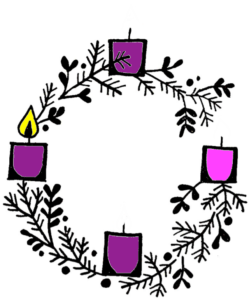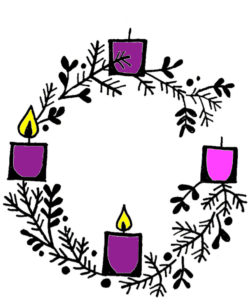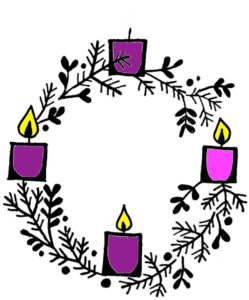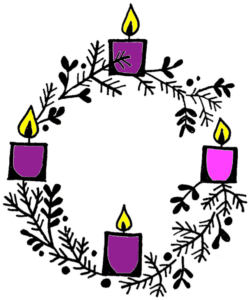(Adapted from an article by Ian Spier, in keepingadvent.com)
 We’re approaching Christmas, now with its traditional colors of red and green — which may be a vestige of the “paradise trees” hung with apples (forerunners of the Christmas tree), or perhaps co me from the holly and ivy that show so vibrantly against a snowy background.
We’re approaching Christmas, now with its traditional colors of red and green — which may be a vestige of the “paradise trees” hung with apples (forerunners of the Christmas tree), or perhaps co me from the holly and ivy that show so vibrantly against a snowy background.
 Before we get there we make our way through Advent, the first season of the Church year, purple or blue, with a splash of pink, move to the center. Advent is a waiting season, and also a penitential season, reflecting on our longing for light to dispel darkness: both the darkness of a planet tilted away from the sun, and the gloom that comes with sin, our tilting away from God. Purple is associated with sorrow, prayer, and penitence. It’s the liturgical color for Lent, and history suggests that Advent developed as a kind of parallel to Lent — both are seasons of preparing for the great celebratory feasts, Christmas and Easter.
Before we get there we make our way through Advent, the first season of the Church year, purple or blue, with a splash of pink, move to the center. Advent is a waiting season, and also a penitential season, reflecting on our longing for light to dispel darkness: both the darkness of a planet tilted away from the sun, and the gloom that comes with sin, our tilting away from God. Purple is associated with sorrow, prayer, and penitence. It’s the liturgical color for Lent, and history suggests that Advent developed as a kind of parallel to Lent — both are seasons of preparing for the great celebratory feasts, Christmas and Easter.
 To distinguish Advent from Lent, many Protestant churches use deep or royal blue instead of purple. Blue symbolizes royalty: a coming King. It’s also the color of the sky in the cold, dark hours just before dawn. Blue perfectly reflects the expectant, hope-filled themes of Advent.
To distinguish Advent from Lent, many Protestant churches use deep or royal blue instead of purple. Blue symbolizes royalty: a coming King. It’s also the color of the sky in the cold, dark hours just before dawn. Blue perfectly reflects the expectant, hope-filled themes of Advent.
Even in contemplative and penitential times, there is relief! The Sunday of Joy marks the third Sunday of Advent, so we light a rose-colored candle.
 Finally, white and gold mean joy, celebration, triumph, and glory. They’re the colors for both Christmas and Easter. The Christ candle at the center of the Advent wreath, which is lit on Christmas Day and throughout the 12-day Christmas season, is often white or gold.
Finally, white and gold mean joy, celebration, triumph, and glory. They’re the colors for both Christmas and Easter. The Christ candle at the center of the Advent wreath, which is lit on Christmas Day and throughout the 12-day Christmas season, is often white or gold.
Red and green will always be popular during this season, but consider using some of the traditional colors in your own holiday practices. Bring some color into your home to remember the journey through Advent and Christmas — and if the color gives you pleasure, too, that brings joy to the heart of God!
